Text
“Get Out” and “Ready or Not”
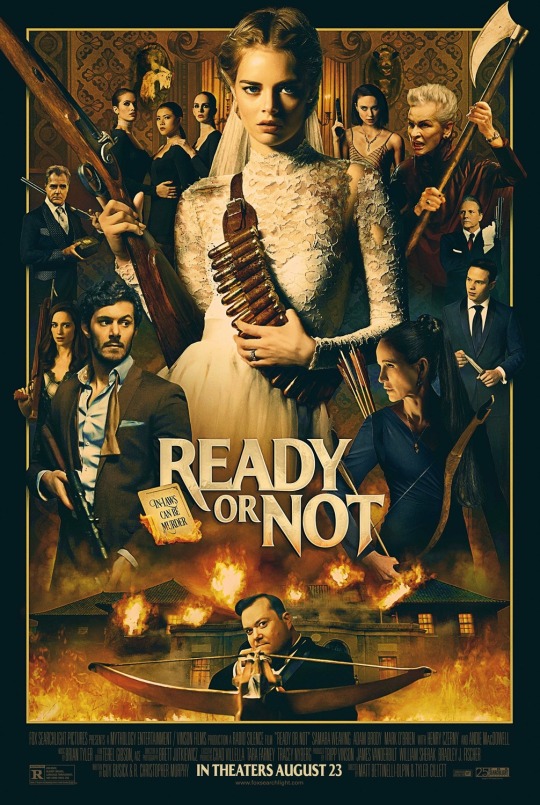
The 2017 film “Get Out” surprisingly has a lot in common with the 2019 film “Ready or Not”. Although “Get Out” follows the story of a black man and “Ready or Not” follows the story of a white women, the films have very similar ideas. “Get Out” follows the dangerous story of Chris as he meets his white girlfriend’s family; the family turns out to be crazy and horribly racist as they steal the bodies and minds of African Americans that they have lured to their plantation style home. “Ready or Not” is also a horror styled film that follows the story of Grace who marries into a wealthy and large family of psychopaths; the family has a game company and every new member of the family has to play a game with them. Unfortunately for Grace, she pulls the game hide and seek; it is revealed that during this game she can only win if she is not killed by the rest of the family. Like Chris, Grace is able to escape by the end of the film, however, she too must kill the whole family to do so.
Both “Get Out” and “Ready or Not” reveal to the audience the dangers of the white upper class. Both protagonists, both Chris and Grace are not wealthy individuals. Chris is a photographer and a working class man; his best friend is a TSA agent. Grace is a foster child who has never had much in life and is now marrying into a family of wealthy people who have owned a game company for years. When Chris arrives at his girlfriend Rose’s childhood home, the house and property are extremely large and resembles a plantation. Rose’s father is a neurosurgeon and her mother is a therapist, both positions that offer a large paycheck. It is very evident that Rose’s family is extremely wealthy and therefore they are used to getting their way. Because of their wealth, her family is able to take advantage of African Americans, a racial group that is often considered in a lower class economically due to the disadvantages they face in everyday life. The inclusion of Rose’s wealth reveals the racism associated with wealth and the money behind white supremacy. Rose is able to have family money as the rich white men in her family have never had a risk to their money due to their high societal standing. Overall, Rose’s family in “Get Out” reveals the wealthiness of white supremacy and the unfair advantages given to wealthier white Americans. A similar idea is explored in “Ready or Not” as Grace meets the family of her husband Alex, the Le Domas family. The family owns a large business and are extremely wealthy due to the success of their game company. When Grace is welcomed into the family she is immediately met with danger; these games have been going on for decades, but due to the wealth of the Le Domas family, no one has ever brought the problems into light. It is not until Grace must fight to the death and survives against the entire family that their evil is revealed, but even that occurs off screen. Both the events of “Ready or Not” and “Get Out” reveal the power of the elite upper class in both a social and economic standpoint.
Although “Get Out” has a focal point on racism and the idea of the white family actively seeking to hurt African Americans, there are many similarities between this film and “Ready or Not”. Both films work to attack the elite upper class consisting of white Americans and mainly male white Americans. It is important that as a society, people are able to hold the elite members accountable to the horrors they commit. Both of these films reveal what may occur if these people are allowed to continue acting with no repercussions.

0 notes
Text
“Get Out” and “The Help”
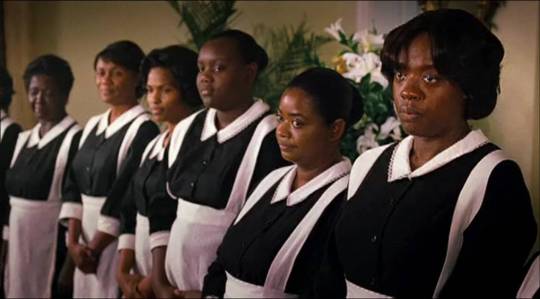
The 2017 film “Get Out” and the 2011 film “The Help” both reveal the struggles faced by African Americans throughout history. One film, “Get Out” reveals current struggles still faced by African Americans in more recent decades. The other, “The Help” focuses more on the struggles faced by African American houseworkers during the civil rights era as African Americans fought for equal rights. Although these films take place during different times, there are many similarities regarding the struggles of the main characters; throughout history the struggles of African Americans have remained very similar.
One similarity between “Get Out” and “The Help” is the idea of African American houseworkers and servants. In “The Help” the main characters are black maids who work in the homes of the wealthy white homeowners. They do everything from the cooking and cleaning to the raising of the children. This idea is seen again in “Get Out”. During the scene in which Chris is getting a tour of the house, he becomes acutely aware of the presence of the black staff. There appears to be a black maid and a black groundskeeper. Chris is immediately made uncomfortable by them as it appears the family believes African Americans are meant to be servants. The inclusion of this imagery connects “Get Out” to “The Help” because it reveals these same racist ideals still affect and terrify African Americans to this day. In actuality, Chris was correct in assuming the family saw African Americans as servants as the family was taking the bodies of black people and using them as their own; the bodies themselves were used to serve the white families. The idea of African Americans remaining servants to white people is very haunting as it shows that society is still very far from equality. There needs to be a change in society in order for African Americans to be able to release their fear of servitude, a fear that was created by the actions of white people.
Another similarity between the two films is the strength and resilience in the main characters.In “Get Out” the main character Chris, and even his comedic best friend Rod, reveal they are both strong, brave and resilient. Chris is forced to use his natural instincts and trust his gut when facing off against Rose and her evil family. Chris then has to fight his way out of the house and has to constantly outsmart the family. Rod is also forced to be strong and resilient as he fights to save his best friend. Rod has to keep constantly working and solving puzzles in order to solve the mystery of the disappearances of black people. He then puts himself in danger to go and save Chris. It is very important for young black children to see the good guys in films as African Americans. The strength shown on screen is also very important for a black audience; the friendship between Rod and Chris reveals the humanity of black men and is just as important. Overall, “Get Out” did an excellent job in properly portraying black men as strong and brave and allowing them to be the heroes of the film. “The Help” also contains strong and brave black characters, this time using black women. Minnie and Aibileen are both brave women who put their lives at risk in order to reveal the cruelties faced by African American houseworkers. Although sometimes their actions cause them to lose their jobs and endanger their lives, like Minnie using the indoor toilet, the women continue fighting for what they deserve and do not stop until their message is spread. “The Help” is a very important film to the African American community as it reveals how strong and brave African American women are and why they deserve to be treated with the utmost respect. Both “The Help” and “Get Out” reveal the strength and bravery of African Americans and are important films to society as a whole.
Although “The Help” does an excellent job in retelling some of the struggles of black maids and servants, it leaves out a significant amount of the violence that truly occurred. In this sense “Get Out” is a more accurately told film as it reveals just how dangerous the lives of African Americans are due to the white populous. The violence and racism seen in “Get Out” tells the audience the risks taken by black people in their daily lives due to the actions of white Americans. Although the violence is very bloody and horrific, and some may find it hard to watch, it is very accurate to the real world. Due to racism and unjust treatment, African Americans face this danger in their daily lives; this makes “Get Out” the more “accurate” film.
Due to both films inclusion of African Americans as “staff” rather than people, as well as the strength and resilience of African Americans being revealed, these films depict racism and the unfairness faced by African Americans. If “The Help” was to show more accurately the violence used against the black housemaids, the film would have been just as accurate as “Get Out”. Overall, both films were well maid and very important to educate society on the struggles of African Americans throughout history.

0 notes
Text
“Get Out”- A Reflection on Modern Day Racism

“Get Out” is a 2017 horror/ psychological thriller film focused on racism. The film follows the story of Chris, a back man traveling with his white girlfriend Rose to meet Rose’s parents. While at her parents’ house, Chris becomes very aware of all of the strange actions of the African American Staff that worked there as well as the only other black man he met. While staying at the house, Chris becomes increasingly uncomfortable and soon wishes to leave; while packing he discovers Rose had had dozens of black boyfriends. He also recognizes one of the men who had been reported missing in the past. As Rose’s mother was a psychiatrist who was skilled in hypnosis and Rose’s father was a neurosurgeon, the family had been kidnapping African Americans and splitting their brains with rich and wealthy friends and family. This led to the white person’s brain completely controlling the black body, while the black person’s mind was stuck falling in “the sunken place”. The point of the procedure was the envy that older white Americans had for African Americans; they craved their stronger, healthier, and more talented bodies. At the end of the film, Chris is able to kill the family and escape with his best friend Rodd.
Overall, this psychological thriller was very enjoyable and forces the audience to focus on the horribly uncomfortable feeling that is associated with the racism that many African Americans feel daily. The white family is very symbolic of this racism. They seem to be perfectly normal and loving; they welcome Chris as one of their own and seem perfectly civilized. It is through Chris’s eyes that we are able to understand just how evil the family is. He is immediately aware of the strange brother, the crying housemaid and the groundskeeper running around at night. Due to his own experiences with racism in the natural world, Chris is able to understand the situations in which he knows he should be uncomfortable.
Another interesting take the film has is in regarding the jealously between upper class white society and African Americans. Although these people believe African Americans to be socially below them, the rich white people are horribly jealous of them. They wish to be as fast as the black men and women, as strong as them, and in the case of Chris, as talented as him. This reveals a deeper layer to racism that is jealously. If one is so racist and evil, why does he so badly wish to have his brain spliced with an African American. This may be due to the jealousy and sense of control that both members of this film and of society feel the need to exert over those they see as less than them.
The most telling and possibly terrifying part of this film is the literal slave auction that occurs while Chris and Rose have gone on a walk. The house itself very closely resembles a slave plantation and already has a black housemaid and a black groundskeeper. At one point in this film while they claim they will be playing bingo, the white society members begin an auction. The item up for grabs is actually Chris. The man who ends up “winning” Chris is a blind art salesman who wants Chris because he knows how good his “eye” is. The slave auction is a terrifying part of the film as it shows that some members of society still to this day view African Americans as less than white people and wish to have a sense of ownership over them. While on a figurative plantation, these wealthy white people, very similarly dressed and acting as slave owners of the past, are bidding on the bodies of African Americans. This is very obviously a remark on slavery as even back then the thing being bet on was the bodies of the black community.
The uncomfortable feeling that one gets as they look through Chris’s eyes throughout the film is meant to reveal to one how awful the feeling of racial anxiety is to African Americans. Chris feels judged and out of place the entire time with everyone’s eyes constantly on him. Chris is representing the feelings of all African Americans as they enter predominantly white areas and are seen as “other”. At one point, Chris walks upstairs and every conversation stops as he walks. Every eye turns to stare at him. This is meant to show the constant judgement that African Americans must undergo daily due to prejudice and racism. The feeling of racism is extremely accentuated at the end of the film when Chris is about to kill Rose and a police car appears. Chris immediately puts his hands up as Rose plays victim. As seen earlier in the film, many police officers are prejudiced against African Americans and immediately assume they are guilty. It is at this point in the film where one sees Chris covered in blood about to kill Rose that the audience understands this officer will see Chris as the guilty party. Luckily, however, the man who leaves the police car is none other than Chris’s best friend Rodd who has had a horrible feeling Chris was in trouble the whole time. This scene is meant to represent the issues surrounding police brutality and racism as the audience felt the true fear of the cop seeing Chris as guilty. This same fear is felt by every African American when they are pulled over or stopped by a police officer; there is a fear that this interaction could kill them.
This film as very well made and perfectly accentuates the fears felt by African Americans in modern day society. “Get Out” is artistically beautiful and meaningful while also providing a strong and clear message.

0 notes
Text
“The Help” and Disney’s “Zootopia”

Although from a surface level the 2011 film “The Help” and Disney’s 2016 animated film “Zootopia” appear to have nothing in common, the messages of these two films are quite similar. “The Help” follows the story of black maids during the 1960s and focuses on the relationship between two specific maids and a white author who work together to battle racism. “Zootopia” follows the story of a bunny and a fox who must work together to reveal that predators are not outright evil animals. One story follows a white person attempting to reveal the racism done unto African Americans and the other rivals a predator and prey working in unison to solve the animalistic “racism”.
The main similarity between “Zootopia” and “The Help” is the relationship between the main characters. In “Zootopia”, the main characters are fox Nick Wilde and bunny Judy Hopps. It is evident that those two do not below together as Nick is a predator and Judy is prey. Despite their differences, Judy and Nick must work together in order to solve the mystery of the missing predators. There is significant racism in the film against predators as they are seen as inherently violent and less civilized than the prey. This is very similar to the racism faced by African Americans during the 1960s. Like the predators in “Zootopia”, African Americans were seen as less civilized than white people and had to work to gain the trust of others; African Americans were see as uncivilized and primal individuals that were created to benefit white people. The irony of this situation is that African Americans were significantly more at risk of being attacked by white Americans and were constantly abused by white people. Judy and Nick, however, are able to work together to solve the mystery despite their different “races”. This is similar to the relationship that is formed between Skeeter, and Aibileen and Minnie. Despite Skeeter being a wealthier white woman and the two maids being African American, the women work together to create Skeeter’s novel. Like Nick and Judy, the women create an unlikely friendship and genuinely care about each other. These three reveal that these differences do not matter and everyone deserves to be treated equally.
Another similarity between the two films is the idea of prejudice. In “The Help”, Skeeter’s mother is a character who is able to overcome her prejudice; Hilly is a character who never does this. Skeeter’s mother, Charlotte, has harmed African American maids in the past and has a prejudice against black Americans. However, as Charlotte learns from her daughter, she comes to terms with her racist actions of the past and is willing to learn and grow. She reads Skeeter’s book and actively tries to be better. In “The Help” Hilly is a white character with significant prejudices that she cannot overcome as she remains racist throughout the whole story. Hilly believes African Americans are so diseased that they must use separate bathrooms, however, she is completely fine with forcing them to cook for her and raise her children. Hilly does not grow from this racism and in the end she loses; Hilly is made an embarrassment and loses respect. In “Zootopia”, Judy is forced to overcome her own prejudiced thoughts. As a child, Judy was attacked and bullied by a fox. As she grows up, Judy remains scared of and hateful towards foxes; this is a problem when she relies on Nick Wilde to help solve the crimes. Judy is forced to overcome her fear and belief that all foxes are evil and is able to form a relationship with a fox. This reveals the importance of overcoming a prejudice; one cannot blame an entire group due to the actions of an individual.
“Zootopia” and “The Help” are both films on racism and the importance of different groups coming together. The creation of “Zootopia” reveals the problems surrounding racism are still relevant today. Through films like “The Help” and “Zootopia” the youth of America is able to learn about the dangers of racism.

0 notes
Text
“The Help” and “Gook”
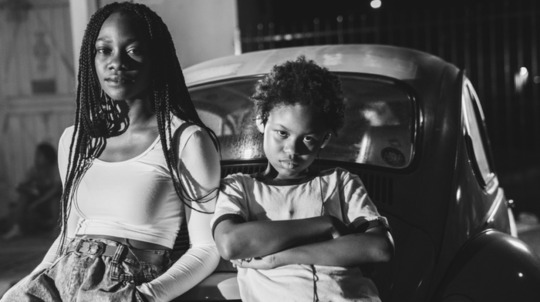
The 2011 film “The Help” and the 2017 film “Gook” both focus on racial issues revolving around minority groups. “The Help” follows the story of black houseworkers during the Civil Rights Era in the 1960s, and “Gook” follows the story of Korean American brothers and their black friend during the 1992 Los Angeles Riots. Both films reveal the social climate at the time of two different eras for African Americans and the effects this has on society. There are tensions in both films.
In “Gook” many details of the story unfold due to the 1992 Los Angeles Riots following the Rodney King trial. In the movie, one can see the cops who assaulted Rodney King come off as not guilty; the result of this trial leads to many African Americans becoming upset. They then begin to loot and riot Los Angeles. One this rioting begins, Eli and Daniel get involved and it is here that much of the violence in the story ensues. One can see how one event can lead to a butterfly effect and cause various things to occur. The riots lead to Daniel getting attacked, and eventually leads to Keith and his gang attacking the boys’ store; this further leads to the accidental death of Kamilla as she attempts to stop the violence between the two boys. A similar event occurs in “The Help” after the death of Medgar Evers. Evers was a civil rights activist and the first state field secretary of the NAACP in Mississippi. Evers was a very important activist and leader to the African Americans during the civil rights movement, but he was assassinated in 1963. In “The Help” one can see the effects that this assassination have on Minnie, Aibileen and the rest of the black houseworkers. It is this assassination that causes the black houseworkers to stop living in constant fear and instead act. When Skeeter returns to work with Aibileen and Minnie, she is instead greeted with the majority of the black maids in Aibileen’s area. Both of these films reveal the effects of social movements on the lives of minorities. In both “Gook” and “The Help” the African Americans in the community become fed up with the injustices they are forced to undergo and instead act out against racism and unfair treatment.
In both “The Help” and “Gook” one can see a change in the feelings of characters due to the events that unfold. In “The Help” one character that changes her perspective is Skeeter’s mother Charlotte. Charlotte had once fired Skeeter’s lifelong maid and motherly figure, Constantine, due to the fact her daughter visited during a luncheon and Charlotte folded under peer pressure. Charlotte also often agrees with the importance of beauty and being a proper white woman; she wishes Skeeter would waste less time writing and instead focus on finding a husband. However, by the end of the film, one can see Charlotte’s perspective change as she begins to come to terms with the wrongs that she did against Constantine and as she becomes proud of her daughter. When Hilly comes to yell at Skeeter about writing her story in the book, Charlotte defends Skeeter and yells at Hilly. One can see Charlotte shift from a cold mother obsessed with the wrong things to a proud mother who has realized the injustices of the world and her and Skeeter are able to have a healthy relationship. In “Gook”, there is also a change in relationship status due to the events of the story. Despite having a long and drawn-out feud, Eli and Keith are forced to work together at the end of the story. When Kamilla accidentally shoots herself trying to break up a fight between Eli and Keith, the boys must put their differences aside and work together to get her to the hospital. Although this alliance comes from a horrific situation, one can see that in dangerous situations, different minorities are able to put their differences aside and work together; these men are also forced to reveal their emotions to one another and be seen in a vulnerable state.
Both “The Help” and “Gook” reveal the effects of racism on different minority groups, especially African Americans. One can use these films to understand the problems revolving around injustices done against African Americans and the effects these injustices have on society as a whole.
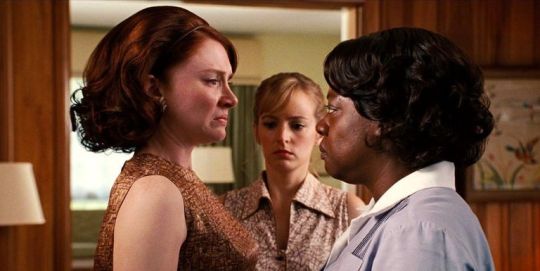
0 notes
Text
“The Help”- A Reflection of African American Houseworkers
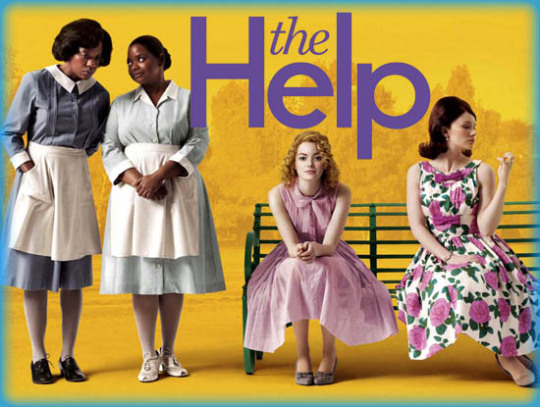
“The Help” is a 2011 film focusing on the struggles of African American women working in the homes of wealthier white people during 1960s America and the Civil Rights Movement. During this timer period, tensions were very high between African Americans and white people as African Americans battled for equal rights. The film follows the story of Eugenia “Skeeter” Phelan as she secretly writes a novel about the struggles of specific black maids in her neighborhood; these maids work for women in her social circle. The maids who’s stories are followed include Aibileen and Minnie. Through the struggles faced daily by these black houseworkers, one can understand the overall struggles of African American women at this time.
The film reveals that in the 1960s, African American women were forced to endure unsafe and dangerous working conditions. Aibileen and Minnie are forced to use bathrooms outside, raise children who are not theirs, and endure constant harassment from the white people they work for. Minnie is eventually fired for using the indoor bathroom despite the tornado going on outside; this specific tornado resulted in the death of many people. Aibileen gets fired towards the end of the movie as Ms. Hilly wishes to get revenge on her for assisting Skeeter in writing the novel. One can see the true love Aibileen has for the children she assists in raising as when she is forced to love Mae, they both end up crying.
The majority of the women in the film are racist, mean and hold little compassion for their black maids and housekeepers. However, a few women like Skeeter, who value African Americans and respect them are seen throughout the film. Among these women is Celia, an ostracized housewife, and Ms. Holbrook, Hilly’s mother. Celia welcomes Minnie as a friend and she and her husband Johnny, offer her a permanent job. Ms. Holbrook openly speaks about and expresses her distaste of the evil within her daughter and is constantly working against the racist acts of Hilly. Although by comparison of the other characters in the movie these women seem like angels, they are still only expressing the bare minimum and in the long run place African Americans below themselves.
Despite the film revealing many of the struggles of African American houseworkers at this time and being relatively progressive, “The Help” still faced criticisms. One problem with this film is the fact that it does not fully reveal the dangers of being black in the 1960s. At this time, houseworkers would get killed and raped just for being black; it was dangerous to be out at night, and people were very prejudiced. Another issue with the film is that it accentuates the stereotype that black men are aggressive, violent and poor fathers and husbands. This is seen through Minnie’s husband who beats her for losing her job, and Aibileen’s husband who is basically absent. This is a dangerous stereotype as black men are just as human as any other person and deserve to be represented as such. Another stereotype seen throughout this film is the black mammy stereotype. This is seen through the docile-ness of the black maids at the start of the film. This stereotype is dangerous as it shows black women as weak and spineless with very little intelligence.
Although the film had a few issues, overall it reveals African American women as multidimensional and displays the struggles of black houseworkers in the 1960s. Through the in-depth analysis of various maids and white allies, one can understand how fighting for equal rights is very difficult and it is not for the faint of heart. Due to the imagery in the film, the characters and relationships formed, “The Help” is an enjoyable film.

2 notes
·
View notes
Text
“Gook” and George Floyd
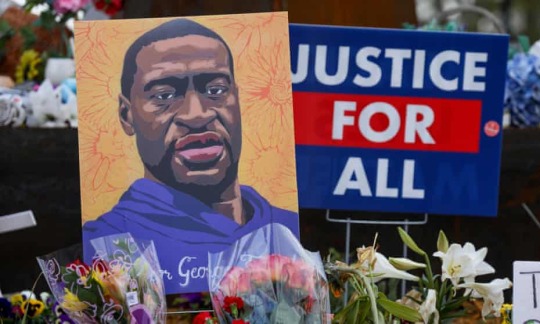
“Gook” is a 2017 film following the story of the effects of the 1992 LA riots caused by the results of the Rodney King versus police case. Rodney King was a black man who was beaten viciously by LAPD officers and arrested. The officers involved in this case were acquitted. The outrage of the trials manifested the LA riots in 1992 that were seen in “Gook” and were the cause of much of the violence occurring in Eli, Daniel’s and Kamilla’s city. Although the story takes place almost thirty years ago, these events still occur in present day America. Most recently, during 2020, a black man George Floyd was killed by police officers in a case of excessive force.
When George Floyd was killed by white police officers, the entire community became involved. Nationwide it affected everyone, no matter their skin color. Although police brutality has been a common trend for years in the US, as seen in “Gook”, the death of George Floyd affected many and restarted the talks of race issues in this country. Similar to the riots seen in “Gook”, the death of George Floyd caused an uproar and protests popped up all over the nation. The phrase “Black Lives Matter” was seen everywhere and tensions were very high between police officers and people of color. One could see the insane widespread affects of one man’s death as he was killed due to racism and the stigma surrounding black men.
In “Gook”, one is able to briefly see the reactions of all the characters as they learn the news that three of the police officers in Rodney King’s case were acquitted; this was a similar emotion as what was felt in the US when people learned of the manner of George Floyd’s death. Due to 2020 being an age of Media, Floyd’s death video was seen everywhere and people of all races were able to see the effects of racism in the police force. For too many decades this has been a problem in the United States; the events seen in “Gook” happened 28 years before the George Floyd tragedy. This reveals that the United States needs to revise its police force and create more strict policies when considering one to be an officer. As seen in both the case mentioned and causing the racial tension in “Gook” and the George Floyd case, one can see the racism in the police force and how dangerous this violence can be. Further explored in “Gook” is the idea that these issues with the police can effect other minority groups besides African Americans; this is explored through the effects of the 1992 LA riots on Korean Eli and Daniel.
Unfortunately, one is able to easily connect “Gook” to the George Floyd case in 2020. Overall, it is evident that white supremacy has a dangerous effect on the United States and continues to harm minorities, specifically with the power struggles existing between African Americans and the police force. One can begin to hope that as time continues and protests continue to affect the media that this hatred and racism comes to a stop.

0 notes
Text
“Gook” and “Moonlight”
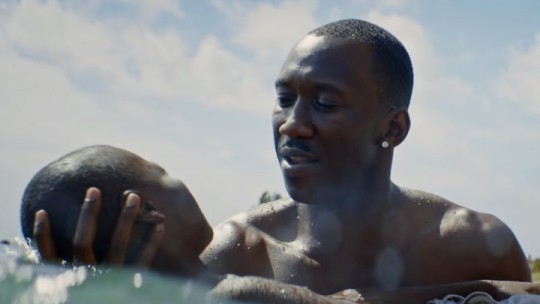
Although they do not take place at the same time, the 2017 film “Gook” and the 2016 film “Moonlight” both focus on the struggles of minority groups in America. “Moonlight” follows the story of a young black man discovering his sexuality in the 1980s in Miami, a time when the war on drugs was at its height. “Gook” is the story of two Korean American boys and their friendship with a young African American girl in 1992 LA, following the story of Rodney King. Both movies follow the struggles of minority groups in the United States, at two different decades and cities, revealing that the problems faced by minorities have remained very universal.
The struggles of eleven year old Kamilla in “Gook” and young Chiron, nicknamed Little, in “Moonlight” are surprisingly very similar. Both children struggle with having parents. Chiron’s mother in “Moonlight” is a single woman addicted to drugs; she does not want anything to do with Chiron, especially once she suspects he is gay. Chiron then searches for a parental figure and finds Juan and Teresa. Similarly, Kamilla lacks proper parents. Her mother was killed and she lives alone with her two siblings. Both siblings are preoccupied and cannot put too much focus into raising her. Kamilla then finds her familial/ parental figures in the form of Eli and Daniel. Daniel and Teresa are very similar in the sense that they are soft and gentle people looking to give their “children” comfort. On the other hand, Juan and Eli are more realistic parents, as they must teach the child the way of the world. Juan teaches Chiron not to sit with his back to the door, and Eli explains to Kamilla why she cannot steal from Mr. Kim.
Another comparison exists between Daniel in “Gook” and Kevin in “Moonlight”. Both of these men are too sensitive of souls as compared to the situation they are placed in. In “Moonlight”, Kevin grows up with violence and his only escape comes in the form of food. Through his ability to cook, Kevin is able to have a real career, open his own restaurant and escape the poverty of Miami.Daniel also has a release he relies on, however, as an audience, one does not get to see how it played out for him. Daniel wishes to be a recording artist and sings. His voice is very delicate as compared to the city around him. When Daniel attempts to break out and record his demo track, he ends up in the middle of the riots and gets ripped from his vehicle. This is a symbol of Daniel’s innocence and pureness in contrast with his environment. Both Kevin and Daniel were forced into situations in which one can only hope they break out from.
Overall, both of these films are able to reveal the struggles of Minority communities in a respectful and explanatory manner. The fact that both films use minority casts and focus solely on their struggles is very important and effective in the spreading of their messages. The similarity between a few of the characters reveals the similarities in the battles faced by minorities, even those of different races. Both “Gook” and “Moonlight” are effective in sharing the struggles of both black and asian minority groups in the US, in an emotional and impactful way.

0 notes
Text
“Gook”- The Effects of White Supremacy on Minority Groups
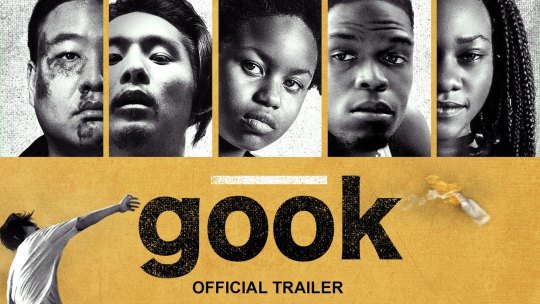
The 2017 film “Gook” is titled after an unfavorable term used for Asian Americans. The director , and one of the starring actors, Justin Chon, wrote the film in order to bring awareness to the 1992 Los Angeles riots due to the Rodney King case. The film follows the story of Eli and Daniel, two Korean- American brothers, and their friendship with a young black girl, Kamilla. Throughout the film, one can see the tensions that exist between Asians and African Americans in LA; these struggles exist due to the racism caused by white Americans.
The friendships between Kamilla and the brothers in this film are very encouraging for the future of the United States, due to the fact it reveals that various minorities can be trusting towards each other. As one can clearly see throughout the film, the tensions between Koreans and black people were very high; one theory as to why this occurred is that, as there were various race struggles for African Americans at the time, the emergence of high populations of another minority, threatened the black community. To elaborate on this, with all of the riots occurring in LA at this time, as well as the police brutality, conflicts between races soared as the white people with power wished to remove themselves completely from the equation. These tensions are very evident through the relationship between Eli and Daniel, and Kamilla’s brother, Keith. However, the friendship between Kamilla and the brothers proves that race is not a boundary when it comes to who one loves; Kamilla sees the Korean boys as her family and works to help them keep their father’s old business afloat. A bond is forced upon Eli and Keith when Kamilla is killed; this proves that smaller conflicts are erased when a loved one is in danger.
One can clearly see, while watching the film, the effects of white supremacy on minority groups. Although the true tensions lay between the white police force and the black community, these problems have caused tension throughout different minority groups. Keith claims to hate Eli and Daniel as his mother was killed at their father’s shop; both Eli’s father and Kamilla’s mother were killed the same day at the store. Keith placed all of his hatred on the boys and blames them for their mother’s death. In reality this hatred is born from fear; Keith is afraid that he has no power to protect his family due to the hardships that were forced upon him at a young age. This fear manifests as hatred and ultimately leads to the death of Kamilla. Perhaps if the black and Asian communities were given equal and fair opportunities, similar to the ones that white Americans are given, these conflicts among minority groups would not exist.
Overall, “Gook” was a very powerful and impactful film. Between the imagery of the black and white filming, Kamilla’s dance before the burning store, or the all minority casting, one can feel the effects of the racism from the 1992 LA riots and associated incidents. This film reveals the negative impacts of white supremacy on minority groups, and explains why hatred can be such a powerful force.

0 notes
Text
“Moonlight” and “Lady Bird”

Although on the surface the 2016 film “Moonlight” and the 2017 film “Lady Bird” may appear to have nothing in common, on a deeper level they are quite familiar with each other. Both films follow the coming of age of the main characters, Chiron in “Moonlight”, and Christine/ Lady Bird in “Lady Bird”. Chiron must face the struggles of being a queer black man, while Christine deals with the trials of a poor income family. Although the characters appear very different, Chiron being a black male, and Christine being a white women, both characters are forced to come to terms with who they are.
A huge similarity between Chiron and Christine are their relationships with their mothers. Chiron’s mother is a drug addict who uses him for money. Christine’s mother is very emotionally absent and they have a very rocky relationship. The idea that despite the differences in their demographics, both characters are able to struggle with similar things. One is also able to see the effects that an absent mother have on a child. Both Chiron and Christine are constantly searching for a way to be loved by their mothers, even if that means acting out. Using these characters, one can begin to understand the importance of a mother in a young person's life. Chiron seeks to find another mother figure and eventually gets lucky enough to find Teresa. Christine’s motherly figure comes from her friend Julie.
Another similarity between these films comes from the main characters becoming something they never expected. Chiron in “Moonlight” was a very sensitive and quiet child; he continues to be a quiet and reserved teenager. However, once he is an adult, Chiron is hardened and tough. This was completely unexpected due to the fact that he was such a gentle child. However, through his rekindling with Kevin, one can see that it is only a surface level of change that Chiron has undergone; deep down he is still the same sensitive boy he once was. Christine also becomes very different then how she was expected to grow up. Christine’s change occurs when she becomes friends with the “cool” group of students. Christine begins to act and talk like a different person and has to try extremely hard to become someone she is not. Through this change, Christine loses her closest friend and has to actively work to get her back. Both Christine and Chiron are caught trying to be someone they both know, deep down, that they are not.
Nicknames are also a shared element between Chiron and Christine. Throughout “Moonlight” Chiron goes through a few nicknames as he attempts to discover his true identity. As a child, Chiron is given the nickname “Little”. This name represents how small Chiron felt and how unsure of himself he was. Later on in his life, Chiron goes by the nickname Black. This nickname was given to Chiron by Kevin when they were teenagers, but Chiron does not embrace it until his adulthood. This resembles how Chiron has completely become the “black” stereotype that men like Juan fought so hard to keep him from. It also reveals that Chiron believes black men need to be hardened and tough in order to be black. It is not until Chiron is reunited with Kevin, and is able to re-embrace his sensitive side that the nickname loses its meaning. Christine in “Lady Bird” also has a strong relationship with nicknames. Christine wishes so hard to be unique and different from others that she gifts herself the nickname Lady Bird. Christine demands people call her by this name and allows it to become her entire personality. It is not until Lady Bird repairs her relationship with her mother, and finally feels remorse for the ways in which she unfairly treats her mother, that she changes her name back to Christine. Both Chiron and Christine reveal the importance of one’s name to one’s identity.
Although the characters of Chiron and Christine appear innately different, through an analysis of both films, one is able to realize that the two characters actually have a significant amount in common. Although it is a difficult journey full of triumphs and defeats, both characters are finally able to reflect upon their true selves.
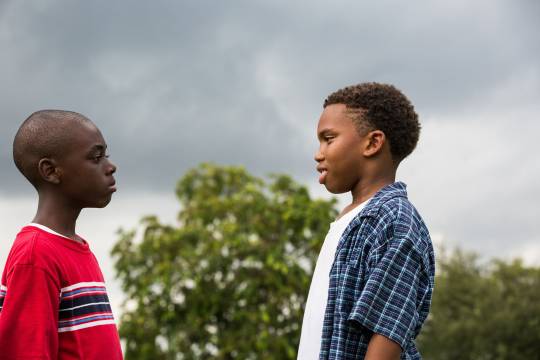
1 note
·
View note
Text
“Moonlight” and “The Breakfast Club”

The 2016 film “Moonlight” and the 1985 film “The Breakfast Club” both relate to the idea of stereotypes and the effects these have on society. A stereotype affects the way in which society views an individual. In “The Breakfast Club” each student encapsulates a different stereotype that could be viewed as common in the typical American high school; throughout the film one can see the students breaking down these barriers and realizing that, despite their stereotypes, they all have a lot in common. In “Moonlight”, Chiron’s character, as well as the other black men in the film, work to break down the stereotypes revolving around African American men in an urban setting. Despite appearing as though they have little in common, these films both revolve around stereotypes.
Another similarity between each film is its attention to one race. In “The Breakfast Club” the entire cast consists of white people. Due to the timing of this film, this is a problem as it shows the lack of representation for African Americans. This shows that in the 1980s, there was a lack of proper representation of African Americans in the media; the directors of the film did not think to include a black student among the stereotypes and instead just focused on the struggles of white students. The lack of white characters in “Moonlight” is actually on purpose. This film was meant to solely focus on the struggles of black people, specifically that of gay black men. The lack of white characters feels natural in the film and allows one to fully see the struggles of this group. It is possible that the lack of white actors in “Moonlight” is in direct conversation with former films, like “The Breakfast Club” that completely ignored the struggles and identity of African Americans.
Chiron in “Moonlight” could have easily been a character in “The Breakfast Club” due to the stereotypes he has to overcome, as well as the fact he could have connected with the other students in detention. Each character in “The Breakfast Club” has a specific stereotype they much overcome. There is the spoiled princess, the nerdy brain, the basket case, the jock, and the criminal. Chiron also has to overcome a stereotype; Chiron has to overcome the idea that black men are supposed to be tough and hardened in society. Chiron has to come to terms with his identity as he is a LGBTQ black man. Chiron also could have related to the other characters in the detention. All of the characters in “The Breakfast Club” bond over their difficult relationship with their parents. Chiron easily fits into this description due to his relationship with his mother; his mother is a drug addict who, when Chiron is a teenager, steals money from him and admits she does not love him. While the students in detention are able to turn to each other for support, Chiron turns towards Juan and Teresa to be his supportive parental figures.
Other characters in both “Moonlight” and “The Breakfast Club” must break out of their societal stereotypes, but some fail to do so. The characters in “Moonlight” are much more dimensional than those in “The Breakfast Club” as they actively work to battle their stereotype as compared to embracing it. Juan, in “Moonlight”, battles his stereotype. Juan is a black drug dealer, however, he is emotionally intelligent and shows Chiron the many ways in which a black man can be warm and loving. Even Chiron’s mother, who appears to be a washed up drug dealer who will die young, battles her stereotype through her trip to rehab and trying to become a better woman and mother. The extra characters in “The Breakfast Club” do not put the same effort into facing their stereotypes. For example the mean detention teacher never becomes anything more.
Overall these films both reveal the harmful effects of stereotypes on very different groups of people. One film, “The Breakfast Club”, lacked diversity due to the poor representation of African Americans, and the other, “Moonlight”, purposefully lacked diversity in order to make a political statement. “Moonlight” allowed one to see the stereotypes that African American men must overcome in order to be kind and understood; “The Breakfast Club” reveals the different stereotypes seen in white high schools and the ways in which these stereotypes are actually similar.

0 notes
Text
“Moonlight”- The stereotypes surrounding LGBTQ African- American Men
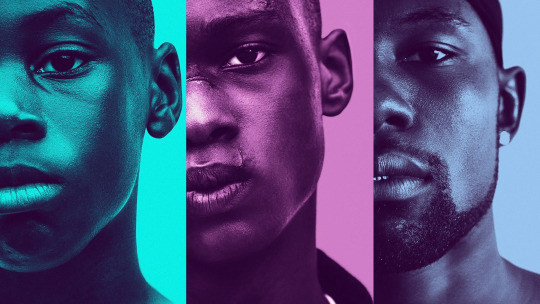
The 2016 film “Moonlight” follows the life of a young black boy, Chiron, as he goes through three different phases of his life. As a young boy, nicknamed Little, Chiron was constantly teased and called the “f” slur. As a teenagers, the second stage of his life titled “Chiron”, Chiron was still teased, however, he made a good friend and explored his sexuality. As a hardened adult, nicknamed “Black”, Chiron becomes tough and is forced to remember his past and rediscover himself. Through the amazing cinematography, as well as the inclusion of a mainly black cast and supportive and emotional black men, one is able to fully understand the character of Chiron as he grows up.
As a young boy, Chiron lacks a supportive parent as his mother is a drug user and single mom. One day, Chiron finds and meets Juan and his girlfriend Teresa who take him in. The importance of these characters is incredible. Juan shows Chiron that black men can be strong and sensitive; Juan is a drug dealer but also teaches Chiron how to swim. Most importantly, Juan teaches Chiron that it is okay to trust other black men and that he truly loves and cares for him. The other lesson taught by Juan is how to be aware of one’s surroundings. Teresa becomes a supportive mother figure to Chiron to contrast the drug addict and absent parent he has at home. Chiron is nicknamed Little at this point in his life; he is unsure of who he is and has not yet come to terms with himself. It is also at this point in his life that Chiron meets Kevin; from the start Kevin supports Chiron and is a friend to him. As a young boy, Chiron tells Teresa and Juan that he is teased for being gay; the two parental figures tell him that he does not need to know his sexuality yet and no matter what it is, it does not matter.
When Chiron is in high school, he is still teased for who he is, who his mother is, and his “adoptive” parents. Chiron obviously struggles with his self identity. One day, Chiron goes to the beach late at night and sees his friend Kevin there. He shares an intimate and romantic moment with Kevin, and it is here Chiron realizes he may be gay. The moment is not again mentioned by the boys. A bully at school later forces Kevin to beat up Chiron, severing the boys relationship with each other. After beating Tyrell up, Chiron goes to jail and the audience next sees him as a grown man. During this phase of his life, Chiron looses his father- figure Juan; this detail is passed over throughout the chapter, perhaps to explain to the audience that death is a normal part of life, especially when one is in a business as risky as drug dealing. The relationship between Chiron and his mother is also partially focused on; this shows the effects of a drug abuser on both themselves and those around them.
In the third chapter of his life, Chiron is a grown man and has become a drug dealer himself. This is ironic as Chiron has witnessed his mother abuse drugs, an activity she is now getting help for, his entire life. This reveals the effects Juan had on Chiron and how much of a father figure he truly was as Chiron follows completely in his footsteps. Chiron’s appearance in the final chapter shows the effects that the bullying he faced as a child had on Chiron; instead of resembling the small and skinny child he was, Chiron is muscular and toughened by the world around him with golden grills and tattoos. Kevin and Chiron reunite as Kevin has opened a restaurant and invited Chiron to eat a meal with him. One can see Chiron forgive Kevin for the actions of their teenage years as it is obvious both men have changed and grown significantly. furthermore, the audience is able to witness the two men have another intimate and soft moment.
The importance of the water and the blue moonlight reveals the sensitivity that exists within black men; this side of African American men is often hidden by the media due to then stereotypes revolving around the demographic. It was amazing to see black men being sensitive and self reflective as this side is not often shown by the media. Too often are black men associated with violence and drugs in the media. The ocean symbolizes the sensitivity of men as it was by the water that Chiron experiences love from other black men; the first instance is learning how to swim from Juan and the other is kissing Kevin for the first time. The symbol of the moonlight surrounds the idea that it is only under the blue moonlight that black men are able to be true and vulnerable.
This movie was incredible enjoyable to watch. The dimensions of the characters were very lifelike and revealed to the audience the levels of a person. The cast made “Moonlight” even better as it consisted of almost completely African Americans. The growth of Kevin and Chiron and the ways in which their lives contrasted each other shows the complexity that exists within loving relationships.
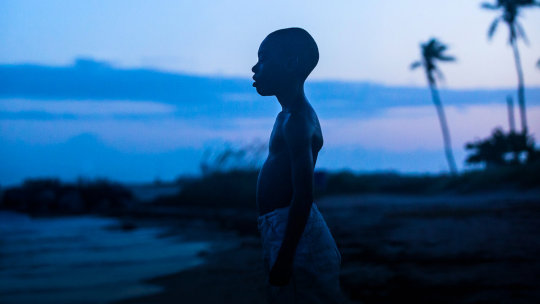
1 note
·
View note
Text
“The Breakfast Club” and “Jumanji: Welcome to the Jungle”

The 1985 film “The Breakfast Club” inspired many similar stories due to its newfound way of expressing the emotions of teenagers. One such story that is very similar to “The Breakfast Club” is the 2017 version of “Jumanji”. This revamped film, based on the 1995 classic, “Jumanji” follows the story of a group of high schoolers after they get sent to detention and become trapped in a video game. One can easily see the similarities between “The Breakfast Club” and “Jumanji: Welcome to the Jungle” due to the stereotypes mentioned, the bonding of the students, and the surprise relationships that arise.
In “Jumanji: Welcome to the Jungle”, the group of students sent to the office and detention all embody a certain stereotype. The popular girl, Bethany, can easily be compared to Claire from “The Breakfast Club”. Both girls appear to embody the “popular princess” stereotype and are both worshipped and slightly hated by their surrounding classmates. The nerdy boy, Spencer, is most like Brian in “The Breakfast Club”. Both boys are “brains” and are viewed as weird and less than their classmates due to their excellence in school; Spencer is in detention due to the fact he got caught doing another student’s homework. The athlete in “Jumanji: Welcome to the Jungle” is Anthony. Anthony is a big time jock who needs to get his grades together; this is very similar to Andy in “The Breakfast Club” as both boys are successful athletes with a lot on the line regarding the future of their career. The final character in detention is the loner, Martha. Martha is most like the “basket case” Allison from “The Breakfast Club” due to the fact that both girls stick to themselves and are seen as social outcasts; the biggest similarity might be from the “shyness” exuding from Martha and the lack of speaking from Allison. Due to the vastness of similarities between “Jumanji: Welcome to the Jungle”, one can infer that the film creators took inspiration from “The Breakfast Club”.
Similarities also exist between the two films due to the bonds formed by the students upon entering detention, and in the case of “Jumanji: Welcome to the Jungle”, upon entering the video game. When the students enter the video game in “Jumanji: Welcome to the Jungle”, they instantly gain the bodies of the characters they are playing. This reduces the levels of separations that exist due to their social standings. For example, the pretty popular girl, Bethany, gains the body of an older chubby man portrayed by Jack Black. The loss of her beauty forces Bethany to rely on other skills when becoming closer with her classmates. The same can be said for Anthony, a tall athletic boy, who gains the body of a short man played by Kevin Hart. For the social outcasts of the group, Martha and Spencer, they gain gorgeous bodies and are able to express themselves due to the lack of insecurities they feel. Similar to how the students in “The Breakfast Club” gain bonds due to their connecting on the problems they each have with their parents, the kids in “Jumanji: Welcome to the Jungle”, become closer as they face life or death and have to count on each other. At the end of “The Breakfast Club”, the students all wonder whether or not they will all be friends on Monday; this same question arises after the students beat the game of Jumanji and return to their normal bodies, however, in “Jumanji: Welcome to the Jungle”, the audience sees the students hanging out on Monday and remaining friends.
The third similarity between “The Breakfast Club” and “Jumanji: Welcome to the Jungle” is the creation of new and unexpected couples throughout the films. In “The Breakfast Club”, at the end of the film two unlikely couples walk out together. The first consists of Andy and Allison, the jock and the basket case. The second couple is John Bender, the criminal, and Claire, the princess. Part of the excitement of watching the film is seeing these very unlikely couples fall for each other despite their differences. A strange couple also arises at the end of “Jumanji: Welcome to the Jungle”. At the end of this film, the audience sees Martha and Spencer fall in love, however, throughout the film they were falling for each other in their video game bodies; the excitement here was seeing if the love lasted despite the change in their appearances.
Overall, both films are very similar in different aspects. One can clearly see the different levels of inspiration that the creators of “Jumanji Welcome to the Jungle” had from “The Breakfast Club”. This is interesting to see as one would like to understand the influence older films have the modern day media. This reveals the timelessness of “The Breakfast Club”, as well as society’s, both past and present, obsession with fulfilling the rolls of stereotypes, especially in a teenage/ high school setting.
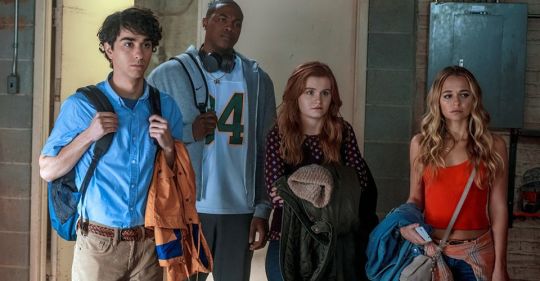

1 note
·
View note
Text
“The Breakfast Club” and “The Namesake”

The 1985 film “The Breakfast Club” and the 2006 film “The Namesake” have a lot in common regarding the lives and troubles of teenagers in the US. “The Breakfast Club” focuses on the lives of stereotypical white American teenagers, while “The Namesake” follows the story of an Indian American teenager.
The biggest contrast between the two films is in regards to the main stereotypes being portrayed. “The Breakfast Club” follows the stereotypes of many different American teenagers including, a princess, a criminal, a brain, an athlete and a basket case. Each of these students represents their stereotype, however, throughout the film, the students are able to understand they all have something in common. The main stereotype being represented in “The Namesake” is the child of an immigrant, or a minority stereotype. Despite these stereotypes being different, the struggles of the teenagers are similar. Both films have teenagers that struggle with acceptance of their role in society. In “The Breakfast Club”, Claire does not love the idea that she is portrayed as a spoiled, popular princess in the eyes of her classmates and now friends. This is similar to Gogol in “The Namesake” who struggles with his identity due to the name his parents have given him; due to his unique name, Gogol is seen as only an Indian with the weird name to his fellow classmates. All the students in both films wish for nothing more than to break out of their respective stereotype and be a more dimensional person. One similar stereotype in the films is the role of the princess. Both Claire in “The Breakfast Club” and Maxine in “The Namesake”, are seen as spoiled rich girls who have been given everything by their parents. However, unseen by the audience, the girls are more two dimensional than they seem. Claire is actually a girl who is used as a weapon by her parents; whenever her parents argue, the other uses her as a way to gain leverage. Maxine is more than just a spoiled rich girl; she is kind and compassionate and is always there for Gogol when he needs her. aid is feasible, that if “The Breakfast Club” was written in a modern setting, a character like Gogol could be included in order to represent the stereotypes that minorities must live through.
“The Namesake” is more respectful and representative of the dimensionality of females than “The Breakfast Club” is. In “The Namesake” there are many successful female characters including Ashima, Sonya, Moushumi and even Maxine. Ashima is an immigrant mother who, although she exhibits typical motherly duties, ensures her children are cared for and loved. Sonya is the child of an immigrant, who instead of feeling out of place, is successful and accepted by her peers. Maxine is an educated and smart woman. Moushumi might be the most dimensional character. She is educated and decides to cheat on Gogol due to her fear of being a typical Indian housewife; this reveals the fear that many women have regarding their futures, and their hope to aspire to more. The women in “The Breakfast Club” are less developed. There are only two main women in the film, Allison and Claire. Allison is seen as a crazy and dreamed character, while Claire is a spoiled brat. Both women are involved mostly in talks of sexual actions. Claire is bullied into admitting she is a bully, while Allison, a compulsive lair, claims to be a nymphomaniac. The obsession of the women and sex reveals “The Breakfast Club” to be a more sexist and male driven movie than “The Namesake”
Both films were interesting and exciting. They each offered an inside look to the minds of teenagers in both the early 2000s and the 1980s. There lies an interesting contrast between the lack of racial representation between these two time periods, as well as the change in respect for women. Although “The Breakfast Club” contains more stereotypes, “The Namesake” provides a more thorough understanding of the stereotypes used in the films, as well as a more respectful breakdown of female characters.

1 note
·
View note
Text
“The Breakfast Club”- The Portrayal of Teens in the Media

The 1985 film “The Breakfast Club” directed by John Hughes offers a very enjoyable and effective display of the stereotypes existing in teens and high schools. This film can be described as a coming of age drama film that features five high school students who are going to school on a Saturday for an all day detention. The best part of this film arises when, despite their stereotypes, the teens realize they are not that different.
The stereotypes seen in the film are as follows: the princess, the brain, the basket case, the athlete and the criminal. Each character personifies their stereotype. Claire, the princess, dresses like a preppy school girl and is treated perfectly, on the surface, by her parents. Brian, the brain, is the perfect student and is seen as nerdy, even down to his lunch. Allison, the basket case, dresses crazy, and has people assuming that she “does not speak”. Andy, the athlete, is a wrestling star who has a full ride scholarship on the line and it is important that he does not get in trouble again. The final student in detention, John Bender, the criminal, has piercings, dresses like a punk and always speaks of his criminal and dangerous actions. Although each of the students comes from very different walks of life, are in different social groups, and are seen completely different by their peers, the students are able to understand that they have a lot in common. The main similarity that exists between the students is the problems existing between them and their parents. Although it seemed as though Claire was her parents perfect princess, in reality her parents used her as a tool to argue with and a weapon against the other parent. Brian may appear to be the perfect student, however, he attempted to kill himself due to the fact he was failing Shop class and was afraid to tell his parents about the bad grade. The basket case, Allison, wishes to run away more than anything else; she went to detention because she had nothing better to do. Andy was in detention due to the fact he felt the need to act up in order to prove something to his father; Andy was seen only as the perfect athlete in the eyes of his coach and his father. lastly, John Bender is constantly abused and beaten by his father and the “criminal” appearance is just and outward shell to defend himself with.
The bonds created by the characters also shows an aspect of how one’s actions can affect others. When Andy is sharing the story of how he got detention, Brain is already aware of the situation. Andy had taped a student’s butt cheeks together; when the tape had to be ripped off, it caused skin and hair to be ripped off causing the student immense pain. Brian’s face immediately drops as he knew the kid who was harassed. This reveals to the audience that all of one’s actions affects other people and can be harmful to people not even directly involved in the situation.
Although the film was very forward thinking in the sense that it showed the struggles of teenagers in a way that had never been explored, it also was very homophobic and misogynistic. Throughout the film, Bender is seen practically sexually assaulting Claire. He hints at her sexuality multiple times, shames her for being both a slut and a virgin. He also inappropriately touches her as he hides under the table from the teacher. Despite Bender mistreating Claire in these ways, at the end of the film he still gets the girl. This is not a feminist film as it reveals that, apparently, men do not need to treat women properly in order to win her over. The film is also borderline homophobic due to its casual and carefree use of the “F” slur, a derogatory and rude term for homosexuals and members of the LGBTQ+ communities.
Overall, the film has a positive effect on the media due to its portrayal of teenagers as human beings who have feelings, just as adults do. “The Breakfast Club” shows the complexity of teenage emotions and the effects of their parents on the lives of these teenagers. However, despite the positives, the film does nothing in regards to female empowerment. The women in this film are constantly involved in sexual talks and the male characters are seen harassing them specifically regarding this topic. The film also holds little respect for the queer community and focuses only on straight characters.

0 notes
Text
“The Namesake” and “Never Have I Ever”

“The Namesake” and the 2020 Netflix series “Never Have I Ever” have a lot in common due to the fact both focus on an Indian family in the United States. While “The Namesake” follows the life of Gogol, an Indian boy who is raised by Indian immigrants and dealing with the effects of racism, Devi in “”Never Have I Ever” is a young Indian girl being raised by Indian immigrants and living with her proper Indian cousin.
An important similarity between the show and film is the fact that both characters are forced to adapt after the death of their parent. In “The Namesake”, Gogol’s father passes away while he is away with his white girlfriend’s family. Gogol must identify the body and then return to his family and mourn with them. This forces Gogol to be very introspective and become more in tune with his Indian ancestry. “Never Have I Ever” shows the affects that Devi’s father's sudden passing had on her and her family. Devi’s father was an important piece in her family and allowed Devi to be herself, while her mother wanted her to be a more traditional Indian girl. Similar to Gogol, Devi becomes “more Indian” after the passing of her father. Both pieces of media allow one to see the affect of the passing of a father on a family.
The show and film also show the effects of assimilation on a family. Both Devi’s and Gogol’s families come from India and must face various aspects of American society. Neither family forces their children to completely assimilate. Both Gogol and Sonya, and Devi are allowed to wear American clothes, eat American snacks and watch American television and media. They re able to be American as well as Indian. The parents understand that their children must be in touch with where they come from, India, as well as where they are living, America. Due to the fact that they are Indian, both Gogol and Devi are harassed and bullied by their classmates, but they are both able to make friends as well. Gogol gets teased by his classmates in high school, however, he has a relationship with a white woman he loves in college. Devi also gets teased because of her name, but she has many friends and also dates a white person she cares deeply for.
Both “The Namesake” and “Never Have I Ever” feature Indian casts playing Indian roles. This is important because they are able to properly represent Indian culture.
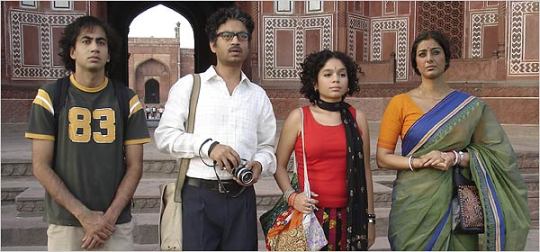
0 notes
Text
“The Namesake” and “Mi Familia”- The Meaning of Family
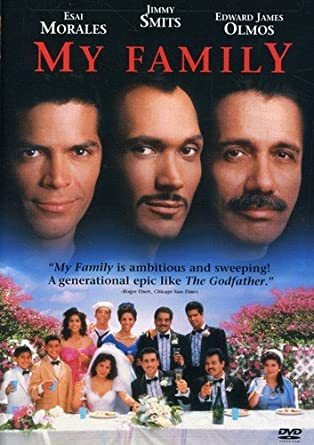
The film “The Namesake” released in 2007 and the film “Mi Familia” released in 1995 have a lot in common. Both films accentuate the importance of family and do so using other cultures. “The Namesake” follows an Indian family while “Mi Familia” follows a Mexican family. Both films also show the effects of racism on the lives of immigrant families. Most importantly, both films are respectful of the cultures they are representing and do so using a cast actually made up of these cultures.
Both “The Namesake” and “Mi Familia” use immigrant families to show the importance and meaning of family. Despite all the struggles that each family undergoes, they are able to come back and have each other. Despite the arguments that Gogol and his parents have, when Ashoke passes away, Gogol immediately returns home. He stays home and abandons the “white life” he was in the process of obtaining. Gogol becomes who his mother and sister need him to be at that time. Sonya also comes home from her life to take care of and be there for her family. The death of Ashoke simultaneously breaks the individual members of the family while also bringing them closer together. The closeness of this family can be compared to the family in “Mi Familia”. An example in which the entire family comes together would be Irene’s wedding. In this moment, the family was able to put each of their individual problems away and just be there for their sister. Both of these films reveal to the audience that when one’s family needs them, no matter what is going on, they will be there for each other. A member in each of these families both struggle with identity as well. Gogol changes his name to Nikhil, and goes by Nick, in order to appear more American in “The Namesake”. Memo, one of the youngest members of the family in “Mi Familia” begins to go by William when he becomes a lawyer in order to appear less Mexican. This reveals that similar problems are felt by immigrants no matter where they are from.
“The Namesake” and “Mi Familia” both reveal the affects that racism have on immigrant families. In “The Namesake”, Gogol deals with significant racism due to his name. Gogol gets teased in high school, and once he graduates, Gogol actually changes his name to a more americanized one. Gogol’s family also experiences racism simply because they are Indian. Their home gets vandalized while they are on vacation in Indian and the mailbox is painted with the words “Gangrene”. The racism faced by the Ganguli family is similar to the racism faced by the Sanchez family in “Mi Familia”. This family deals with various issues surrounding the deportation police. Maria, the matriarch of the family, is taken by police and brought back to Mexico despite being a pregnant American citizen. Later, Jimmy marries a woman because she is also getting taken by the police. The family also faces profiling and gets given the lesser of things, including medical care. When Jimmy’s wife dies in childbirth, he believes it is because of the medical care they received. Both families also experience issues with integrating white members into their families. When Memo brings home his white fiancée in “Mi Familia”, her family treats the Sanchez's poorly and look down on them. When Gogol brings home his white girlfriend in “The Namesake” things become very awkward when she does not respect the rules in their house regarding physical touch.
Overall, both of these films are respectful of the cultures they are portraying, especially due to the fact that the casts consist of the races they are representing. “The Namesake” has Indians representing Indians and “Mi Familia” has latinos representing the family. The films have a lot in common regarding the issues faced by immigrant families and the importance of family.

0 notes